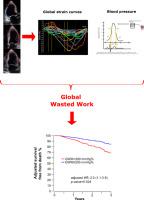Journal of the American Society of Echocardiography ( IF 5.4 ) Pub Date : 2021-06-19 , DOI: 10.1016/j.echo.2021.06.008 Clemence Riolet 1 , Aymeric Menet 1 , Amandine Mailliet 1 , Camille Binda 1 , Alexandre Altes 1 , Ludovic Appert 1 , Anne Laure Castel 1 , François Delelis 1 , Guillaume Viart 1 , Yves Guyomar 1 , Caroline Le Goffic 1 , Marie Decroocq 1 , Pierre-Vladimir Ennezat 2 , Pierre Graux 1 , Christophe Tribouilloy 3 , Sylvestre Marechaux 4

|
Background
The relationship between myocardial work assessment using pressure-strain loops by echocardiography before cardiac resynchronization therapy (CRT) and response to CRT has been recently revealed. Among myocardial work parameters, the impact of left ventricular myocardial global wasted work (GWW) on response to CRT and outcome following CRT has been seldom studied. Hence, the authors evaluated the relationship between preprocedural GWW and outcome in a large prospective cohort of patients with heart failure (HF) and reduced ejection fraction receiving CRT.
Methods
The study included 249 patients with HF. Myocardial work indices including GWW were calculated using speckle-tracking strain two-dimensional echocardiography using pressure-strain loops. End points of the study were (1) response to CRT, defined as left ventricular reverse remodeling and/or absence of hospitalization for HF, and (2) all-cause death during follow-up.
Results
Median follow-up duration was 48 months (interquartile range, 43–54 months). Median preoperative GWW was 281 mm Hg% (interquartile range, 184–388 mm Hg%). Preoperative GWW was associated with CRT response (area under the curve, 0.74; P < .0001), and a 200 mm Hg% threshold discriminated CRT nonresponders from responders with 85% specificity and 50% sensitivity, even after adjustment for known predictors of CRT response (adjusted odds ratio, 4.03; 95% CI, 1.91–8.68; P < .001). After adjustment for established predictors of outcome in patients with HF with reduced ejection fraction receiving CRT, GWW < 200 mm Hg% remained associated with a relative increased risk for all-cause death compared with GWW ≥ 200 mm Hg% (adjusted hazard ratio, 2.0; 95% CI, 1.1–3.9; P = .0245). Adding GWW to a baseline model including known predictors of outcome in CRT resulted in an improvement of this model (χ2 to improve 4.85, P = .028). The relationship between GWW and CRT response and outcome was stronger in terms of size effect and statistical significance than for other myocardial work indices.
Conclusions
Low preoperative GWW (<200 mm Hg%) is associated with absence of CRT response in CRT candidates and with a relative increased risk for all-cause death. GWW appears to be a promising parameter to improve selection for CRT of patients with HF with reduced ejection fraction.
中文翻译:

接受心脏再同步治疗的心力衰竭患者整体浪费工作的临床意义
背景
最近揭示了在心脏再同步治疗 (CRT) 之前通过超声心动图使用压力-应变环评估心肌工作与对 CRT 的反应之间的关系。在心肌工作参数中,很少研究左心室心肌整体无用功 (GWW) 对 CRT 的反应和 CRT 后的结果的影响。因此,作者在接受 CRT 的心力衰竭 (HF) 和射血分数降低患者的大型前瞻性队列中评估了术前 GWW 与结果之间的关系。
方法
该研究包括 249 名 HF 患者。使用压力-应变环的斑点跟踪应变二维超声心动图计算包括 GWW 在内的心肌工作指数。该研究的终点是 (1) 对 CRT 的反应,定义为左心室逆转重构和/或没有因 HF 住院,以及 (2) 随访期间全因死亡。
结果
中位随访时间为 48 个月(四分位距,43-54 个月)。术前 GWW 中位数为 281 mm Hg%(四分位距,184–388 mm Hg%)。术前 GWW 与 CRT 反应相关(曲线下面积,0.74;P < .0001),即使在调整已知的 CRT 预测因子后,200 mmHg% 的阈值仍能以 85% 的特异性和 50% 的灵敏度区分 CRT 无反应者和反应者反应(调整后的优势比,4.03;95% CI,1.91–8.68;P < .001)。在对接受 CRT 的射血分数降低的 HF 患者的既定预后预测因子进行调整后,与 GWW ≥ 200 mmHg% 相比,GWW < 200 mmHg% 仍与全因死亡风险相对增加相关(调整后的风险比为 2.0 ; 95% CI, 1.1–3.9; P = .0245)。将 GWW 添加到基线模型中,包括 CRT 中已知的结果预测因子,导致该模型的改进(χ 2改进为 4.85,P = .028)。GWW 和 CRT 反应和结果之间的关系在大小效应和统计显着性方面比其他心肌工作指数更强。
结论
术前 GWW 低(<200 mm Hg%)与 CRT 候选者没有 CRT 反应以及全因死亡风险相对增加有关。GWW 似乎是改善射血分数降低的 HF 患者 CRT 选择的有希望的参数。











































 京公网安备 11010802027423号
京公网安备 11010802027423号